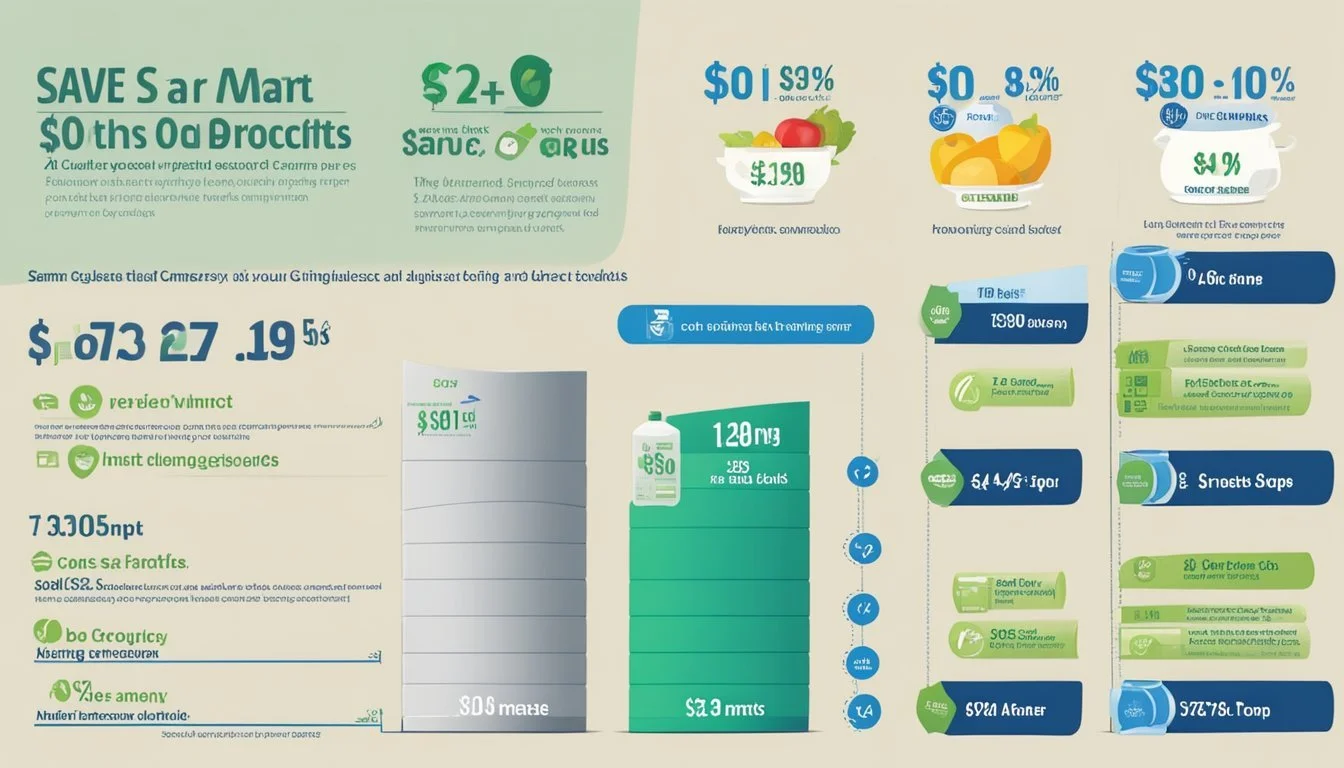Sam's Club vs Save Mart
Price and Quality Comparison
Shoppers seeking the best value for their grocery dollars often compare different stores to find the most savings. Sam's Club and Save Mart represent two distinct retail models - a membership-based warehouse club versus a traditional supermarket chain. Both aim to offer competitive pricing, but their approaches differ significantly.
Sam's Club typically provides lower per-unit prices on bulk items, while Save Mart offers a wider variety of standard-sized products and frequent sales. This key difference impacts how customers shop and save at each store. Sam's Club requires a paid membership but can deliver substantial discounts on large quantities. Save Mart, on the other hand, is open to all shoppers and focuses on weekly specials and loyalty programs.
The choice between Sam's Club and Save Mart ultimately depends on individual shopping habits and needs. Families who consume large quantities of specific items may benefit more from Sam's Club's bulk pricing. Those who prefer a traditional grocery shopping experience with a broader selection of brands and package sizes might find Save Mart more suitable. Comparing prices on commonly purchased items can help determine which store offers the best overall value for a particular household.
Overview of Sam's Club and Save Mart
Sam's Club and Save Mart are two distinct grocery retailers catering to different consumer needs. Sam's Club operates as a membership-based warehouse club, offering bulk quantities at discounted prices.
Save Mart, on the other hand, is a traditional supermarket chain without a membership requirement. It provides a more conventional grocery shopping experience with a focus on fresh produce and local products.
Sam's Club typically stocks a wide range of items beyond groceries, including electronics, furniture, and clothing. The retailer's bulk-buying model often translates to lower prices per unit compared to regular grocery stores.
Save Mart concentrates primarily on food items, household essentials, and health and beauty products. Its stores are generally smaller than Sam's Club locations and offer a more curated selection of goods.
Membership is a key differentiator between the two. Sam's Club requires an annual fee to access its stores and services. Save Mart welcomes all shoppers without any membership obligations.
Sam's Club's larger format allows for expansive product displays and wider aisles. Save Mart stores are typically designed for quicker, more frequent shopping trips.
Both retailers strive to provide value to customers, but through different approaches. Sam's Club leverages bulk purchasing power, while Save Mart focuses on competitive pricing and weekly specials.
Membership and Pricing Structure
Sam's Club offers a tiered membership system with exclusive benefits and pricing structures. Members gain access to bulk purchasing options and special discounts not available to the general public.
Membership Benefits and Limits
Sam's Club memberships provide access to warehouse stores and online shopping. Members can purchase items in bulk quantities at discounted prices. The basic Club membership allows shopping at all Sam's Club locations and online, with up to 8 add-on memberships for family and friends.
Plus members receive additional perks like early shopping hours, free shipping on most items, and 2% cash back on qualifying purchases up to $500 annually. They also get optical and pharmacy savings, as well as discounts on fuel at select locations.
Sam's Club imposes some limits on memberships. For example, resale is prohibited, and there are restrictions on the number of items that can be purchased in a single transaction for certain products.
Comparing Membership Fees
Sam's Club offers two membership tiers: Club and Plus. The Club membership costs $45 annually, while the Plus membership is priced at $100 per year. These fees are generally lower than some competitors in the warehouse club market.
The Club membership provides basic access to Sam's Club stores and online shopping. The Plus membership includes all Club benefits, plus additional perks and savings opportunities.
For budget-conscious shoppers, the Club membership offers good value. However, frequent shoppers or those who plan to take advantage of additional services may find the Plus membership more cost-effective in the long run.
Deals and Discounts Analysis
Sam's Club provides various ways for members to save money. Instant Savings offers are automatically applied to purchases without the need for coupons. These deals rotate regularly and can provide significant discounts on select items.
Members can also access exclusive online-only deals and limited-time offers. The Sam's Club app features digital coupons and allows members to create shopping lists and track their savings.
Plus members receive an extra layer of savings with 2% cash back on qualifying purchases. This can add up to $500 in rewards annually, potentially offsetting the higher membership fee.
Sam's Club also offers special promotions throughout the year, including seasonal sales and member-exclusive events with deeper discounts on popular items.
Product and Brand Selection
Sam's Club and Save Mart differ significantly in their product offerings and brand selections. Each store caters to distinct customer needs through their unique assortment of items.
Exclusive Brands and Products
Sam's Club features its private label Member's Mark across various categories. This brand covers everything from groceries to household staples. Member's Mark products often come in larger sizes, catering to bulk purchases.
Save Mart, in contrast, offers its own store brands alongside national names. These private labels provide budget-friendly alternatives to popular items. Save Mart's selection focuses more on standard grocery sizes rather than bulk quantities.
Quality and Variety Comparison
Sam's Club provides a wide range of name brands and high-quality products. Their inventory includes organic options and premium goods. The warehouse format allows for an extensive selection of non-food items like electronics and furniture.
Save Mart concentrates primarily on groceries and everyday household items. Their produce section typically offers fresh, locally-sourced options. Save Mart stores stock a mix of national brands and regional favorites.
Both stores carry organic products, but Sam's Club often has a larger organic selection. Save Mart may have an edge in variety for specific grocery categories, especially in fresh foods and local specialties.
Grocery Shopping Experience
Sam's Club and Save Mart offer distinct grocery shopping experiences. Each store has its own approach to layout, product selection, and digital services.
Store Layout and Navigation
Sam's Club features a warehouse-style layout with wide aisles and bulk items. Products are often stacked on pallets or displayed in large bins. The store's open floor plan allows for easy navigation, though finding specific items may require some searching.
Save Mart, in contrast, has a traditional supermarket layout. Aisles are clearly labeled, and departments are organized in a familiar pattern. This design makes it simpler to locate specific products quickly.
Sam's Club typically has fewer product varieties but larger quantities. Save Mart offers a wider range of brands and package sizes, catering to different household needs.
Online Shopping and Delivery Services
Sam's Club provides robust online shopping options. Members can use the Sam's Club app or website to place orders for delivery or free curbside pickup. The service is user-friendly and integrates with the in-store experience.
Save Mart partners with Instacart for online grocery shopping and delivery. Customers can browse products, create lists, and schedule deliveries through the Instacart platform. Some Save Mart locations also offer their own pickup services.
Both stores have privacy policies in place to protect customer information during online transactions. Sam's Club's membership model may provide additional benefits for frequent online shoppers.
Bulk Buying Benefits and Strategies
Bulk buying can offer significant savings and convenience for shoppers. It requires careful planning and storage management to maximize benefits.
Maximizing Savings with Bulk Purchases
Comparing unit prices is crucial when bulk buying. Look for the price per ounce or pound to determine if bulk options truly offer savings. Many stores display this information on shelf labels.
Concentrate on non-perishable items and household staples. Paper products, cleaning supplies, and canned goods are ideal for bulk purchases. These items have long shelf lives and consistent usage.
Consider splitting bulk purchases with friends or family. This strategy allows you to take advantage of savings without overbuying. It's particularly useful for smaller households or those with limited storage space.
Watch for sales and promotions on bulk items. Combining discounts with already reduced bulk prices can lead to substantial savings. Keep track of regular prices to spot genuine deals.
Managing Storage and Avoiding Waste
Proper storage is essential to prevent spoilage and maintain quality. Invest in airtight containers for dry goods like rice, pasta, and flour. These containers protect against pests and moisture.
Rotate stock to use older items first. This practice helps prevent food waste and ensures you consume products before their expiration dates. Label containers with purchase dates for easy tracking.
Be realistic about consumption rates. Buying in bulk only saves money if you use the products before they expire. Consider your household's needs and habits before making large purchases.
Freeze perishables to extend their shelf life. Many fruits, vegetables, and meats can be frozen for future use. Portion items before freezing for easy defrosting and use.
Additional Services and Perks
Sam's Club and Save Mart offer distinct services beyond basic grocery shopping. These additional perks can significantly impact the overall value for customers.
Health and Wellness Services
Sam's Club provides comprehensive health services through its pharmacy and optical departments. Members can access prescription medications, immunizations, and health screenings. The pharmacy offers competitive pricing on generic drugs and a free prescription program for select medications.
Save Mart's health offerings are more limited. Their pharmacies provide standard prescription services and some vaccinations. However, they lack the extensive health screenings and optical services found at Sam's Club.
Both stores offer over-the-counter medications and health products, but Sam's Club typically provides a wider selection at bulk prices.
Automotive and Fuel Discounts
Sam's Club excels in automotive services and fuel discounts. Members enjoy access to discounted fuel prices at Sam's Club gas stations. The club also offers tire installation, battery services, and other automotive maintenance at competitive rates.
Save Mart generally does not provide automotive services. Some locations may have affiliated gas stations, but fuel discounts are not a core offering.
Sam's Club Plus members receive additional benefits, including 5% cash back on fuel purchases. This can lead to significant savings for frequent drivers.
Customer Experience and Support
Sam's Club and Save Mart prioritize customer satisfaction through various programs and resources. Both retailers aim to enhance the shopping experience and provide support to their members and shoppers.
Loyalty Programs and Customer Rewards
Sam's Club offers a tiered membership program with exclusive benefits. The basic membership provides access to wholesale prices and fuel savings. Plus members enjoy additional perks like free shipping, early shopping hours, and cash rewards on qualifying purchases. Sam's Club credit card holders can earn up to 5% back on eligible items.
Save Mart operates a digital rewards program called Save Smart Rewards. Shoppers earn points on purchases, which can be redeemed for discounts on future shopping trips. The program also provides personalized digital coupons and special offers through their mobile app. Save Mart's rewards system is free to join and does not require a paid membership.
Support Resources and Privacy Policies
Sam's Club provides customer support through multiple channels. Members can access help via phone, email, live chat, and in-store assistance. The retailer's website features a comprehensive FAQ section and how-to guides. Sam's Club's mobile app allows users to manage their accounts, view digital receipts, and access exclusive savings.
Save Mart offers customer support primarily through in-store service desks and phone lines. Their website includes a basic FAQ section and store locator. Both retailers maintain privacy policies that outline how customer data is collected, used, and protected. These policies typically cover information gathered through loyalty programs, online accounts, and mobile apps.
Cost Efficiency and Household Budgeting
Sam's Club and Save Mart offer different approaches to grocery shopping and household budgeting. Membership-based bulk buying contrasts with traditional supermarket pricing models. Each store has unique strengths for cost-conscious shoppers.
Comparing Overall Expenses
Sam's Club requires an annual membership fee, starting at $55. This upfront cost can be offset by potential savings on bulk purchases. Sam's Club often offers lower per-unit prices on many items compared to traditional grocery stores like Save Mart.
Save Mart doesn't charge a membership fee. This allows shoppers to avoid an annual expense. However, regular prices at Save Mart may be higher on some products compared to Sam's Club's bulk offerings.
For large households or those able to store bulk items, Sam's Club can provide significant savings. Smaller households or those with limited storage may find Save Mart more economical, avoiding waste from unused bulk products.
Budget-Friendly Strategies for Shoppers
Sam's Club excels in bulk buying of non-perishable goods and household items. Stocking up on these products can lead to long-term savings. The store also offers a credit card with cashback rewards on purchases.
Save Mart provides weekly sales and digital coupons. These promotions allow strategic shoppers to save on specific items. Save Mart's loyalty program offers personalized deals based on shopping habits.
Both stores have their own store brands, which are typically cheaper than name brands. Sam's Club's Member's Mark and Save Mart's Sunny Select offer quality alternatives at lower prices.
Comparing unit prices is crucial at both stores. Sam's Club often has lower per-unit costs on bulk items. Save Mart may offer better deals on smaller quantities or perishables.
Additional Considerations for Shoppers
Savvy shoppers should stay informed about market trends and specialized offerings to maximize their savings. Adapting shopping habits and exploring unique product selections can lead to significant benefits.
Adapting to Inflation and Market Changes
Food prices have been volatile, affecting staples like milk, bread, and eggs. Shoppers can mitigate rising costs by being flexible with their grocery lists. Comparing prices on pantry essentials such as pasta, rice, and peanut butter across stores is crucial.
Sam's Club often provides better value on bulk items like toilet paper and diapers. Save Mart may offer competitive prices on fresh produce like carrots, onions, and potatoes. Both stores adjust pricing strategies to remain competitive, so vigilant price-checking is key.
Store brand items can offer substantial savings. Sam's Club's Member's Mark and Save Mart's private labels frequently match name-brand quality at lower prices.
Specialty Items and Seasonal Offers
Sam's Club excels in non-grocery categories, offering deals on electronics, furniture, and housewares. This can be advantageous for smaller households looking to make occasional large purchases.
Save Mart often features local and specialty foods, catering to diverse tastes. Their selection of fresh produce and seasonal items can be more varied than warehouse clubs.
Both stores run rotating promotions. Sam's Club may have better deals on bulk coffee or store-brand wine. Save Mart might offer superior savings on weekly specials for items like chicken thighs or corn.
Seasonal sales can provide significant savings. Sam's Club typically has strong holiday offerings, while Save Mart may shine with local, seasonal produce deals.
Conclusion
Sam's Club and Save Mart offer distinct shopping experiences for consumers. Sam's Club provides bulk purchasing options and potential savings for members. Its warehouse-style stores carry a wide range of products beyond just groceries.
Save Mart, on the other hand, focuses primarily on groceries and fresh produce. It caters to shoppers seeking a traditional supermarket experience with regular-sized product options.
Price comparisons vary by specific items and locations. Sam's Club may offer lower per-unit costs on bulk purchases. Save Mart frequently provides weekly deals and promotions on everyday groceries.
Selection differs between the two. Sam's Club stocks a broader variety of non-food items. Save Mart typically has a more extensive produce section and local offerings.
Convenience factors into the choice. Sam's Club requires a paid membership. Save Mart allows open access to all shoppers.
The better option depends on individual shopping habits, household size, and preferences. Families who buy in bulk may benefit more from Sam's Club. Those who prefer smaller quantities and frequent grocery runs might find Save Mart more suitable.










